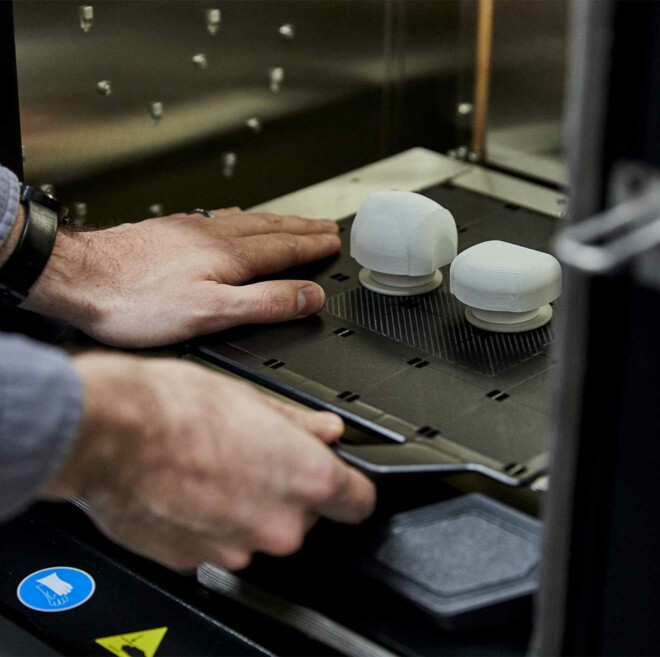Prototyping & Testing
Within our large in-house workshop and prototyping facilities, we create, test and refine physical parts to verify form, fit and function.
3D Printing Why prototype? Less risk; Better designs
3D printing has transformed new product development. It allows fast, cost-effective manufacture of complex parts that significantly reduces development time and risk. Designers and engineers no longer need to rely on simple handmade mock ups or expensive CNC machined parts that take weeks to manufacture. Now parts can be designed, 3D CAD modelled and printed all within a day, accelerating the development process by facilitating fast and efficient design optimisation.
Cobalt has an array of industrial-quality 3D printing machines in house. These include the latest in thermally insulated FDM technology printers from industry leaders Stratasys and Ultimaker, and allow manufacture of parts in a wide range of materials and colours, including complex mutli-material prints.

Visual Prototypes The shape of things to come
Evaluating a product’s shape, appearance, ergonomics, and scale is a key part of the early development process. And despite our sketching and rendering expertise, many aspects of a design can only be expressed through a physical object, Visual prototypes (or form models) allow our team and yours to experience the concept in a physical form, often for the first time. Visual prototypes also enable greater stakeholder input as more people can understand 3D objects more intuitively than 2D sketches.
Cobalt uses a variety of methods to create visual prototypes, selected depending on the end need. These range from simple foam models used for form studies and design iteration, through to highly detailed models that may be used for more involved concept evaluation or early sales and marketing activities. For transport and similar developments we can use automotive clay to literally sculpt shapes highly refined forms.

Functional Prototypes The first glimpse of the final design
With our in-house prototyping and 3D printing workshop, and an extensive network of external suppliers, Cobalt can produce working prototypes to meet any purpose. Also known as Alpha or working prototypes, functional prototypes are often the first time all the elements of the design are combined into a single object as intended for the final product; allowing a variety of evaluation activities to be undertaken. These include functional and performance tests, usability and user experience feedback, ergonomic studies, pre-compliance tests, pre-clinical trials and many regulatory approval tests.
Coming at the end of the first engineering stage, functional prototypes form a pivotal milestone in the development process. They often validate the overall concept, but also identify issues that require further refinement; which of course is the very purpose of prototyping.
Cobalt can manage the manufacture of functional prototypes that range from single and multiple units through to small-batch production quantities

Testing & Evaluation Verify form, fit & function
Product testing and evaluation goes hand in hand with prototyping to put a design through its paces. With a fully equipped workshop and testing facility, Cobalt’s designers and engineers can design, develop and perform a variety of function, performance and usability tests to check, validate components, assemblies and functionality.
Our test facilities extend to:
- Metrology and inspection devices
- Physical testing (drop and load tests; water ingress; heat, seal, repetition, sound and thermal performance testing),
- Data acquisition and logging
- Electronics testing facility
Cobalt also has strong relationships with external and certified test organisations and can assist with compliance or regulatory testing, along with pre-clinical and clinical trials.



